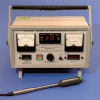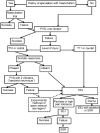Advances in the management of infertility in men with spinal cord injury
- PMID: 27048781
- PMCID: PMC4854086
- DOI: 10.4103/1008-682X.178851
Advances in the management of infertility in men with spinal cord injury
Abstract
Couples with a spinal cord injured male partner require assisted ejaculation techniques to collect semen that can then be further used in various assisted reproductive technology methods to achieve a pregnancy. The majority of men sustaining a spinal cord injury regardless of the cause or the level of injury cannot ejaculate during sexual intercourse. Only a small minority can ejaculate by masturbation. Penile vibratory stimulation and electroejaculation are the two most common methods used to retrieve sperm. Other techniques such as prostatic massage and the adjunct application of other medications can be used, but the results are inconsistent. Surgical sperm retrieval should be considered as a last resort if all other methods fail. Special attention must be paid to patients with T6 and rostral levels of injury due to the risk of autonomic dysreflexia resulting from stimulation below the level of injury. Bladder preparation should be performed before stimulation if retrograde ejaculation is anticipated. Erectile dysfunction is ubiquitous in the spinal cord injured population but is usually easily managed and does not pose a barrier to semen retrieval in these men. Semen analysis parameters of men with spinal cord injury are unique for this population regardless of the method of retrieval, generally presenting as normal sperm concentration but abnormally low sperm motility and viability. When sperm retrieval is desired in this population, emphasis should be placed on initially trying the simple methods of penile vibratory stimulation or electroejaculation before resorting to more advanced and invasive surgical procedures.
Figures





Comment in
-
The importance of sexual function in men with spinal cord injuries.Asian J Androl. 2016 May-Jun;18(3):391. doi: 10.4103/1008-682X.179247. Asian J Androl. 2016. PMID: 27048788 Free PMC article. No abstract available.
Similar articles
-
Male fertility following spinal cord injury: an update.Andrology. 2016 Jan;4(1):13-26. doi: 10.1111/andr.12119. Epub 2015 Nov 4. Andrology. 2016. PMID: 26536656 Review.
-
[The spinal cord injured patient: semen quality and management by Assisted Reproductive Technology].Gynecol Obstet Fertil. 2010 Sep;38(9):532-5. doi: 10.1016/j.gyobfe.2010.07.007. Epub 2010 Aug 11. Gynecol Obstet Fertil. 2010. PMID: 20705499 French.
-
Penile vibratory stimulation and electroejaculation in the treatment of ejaculatory dysfunction.Int J Androl. 2002 Dec;25(6):324-32. doi: 10.1046/j.1365-2605.2002.00378.x. Int J Androl. 2002. PMID: 12406364 Review.
-
Penile vibratory stimulation in men with spinal cord injury: an educational video demonstration.Fertil Steril. 2024 Mar;121(3):545-547. doi: 10.1016/j.fertnstert.2023.12.013. Fertil Steril. 2024. PMID: 38368076
-
Electroejaculation in men with spinal cord injury: a step-by-step video demonstration.Fertil Steril. 2021 May;115(5):1344-1346. doi: 10.1016/j.fertnstert.2021.01.012. Epub 2021 Mar 10. Fertil Steril. 2021. PMID: 33712290
Cited by
-
Constructing and Validating a Network of Potential Olfactory Sheathing Cell Transplants Regulating Spinal Cord Injury Progression.Mol Neurobiol. 2023 Dec;60(12):6883-6895. doi: 10.1007/s12035-023-03510-9. Epub 2023 Jul 29. Mol Neurobiol. 2023. PMID: 37515671
-
A Primary Care Provider's Guide to Sexual Health for Individuals With Spinal Cord Injury.Top Spinal Cord Inj Rehabil. 2020 Summer;26(3):144-151. doi: 10.46292/sci2603-144. Top Spinal Cord Inj Rehabil. 2020. PMID: 33192040 Free PMC article.
-
Sexuality, Intimacy, and Reproductive Health after Spinal Cord Injury.J Pers Med. 2022 Dec 1;12(12):1985. doi: 10.3390/jpm12121985. J Pers Med. 2022. PMID: 36556205 Free PMC article. Review.
-
Neural Control and Physiology of Sexual Function: Effect of Spinal Cord Injury.Top Spinal Cord Inj Rehabil. 2017 Winter;23(1):1-10. doi: 10.1310/sci2301-1. Top Spinal Cord Inj Rehabil. 2017. PMID: 29339872 Free PMC article. Review.
-
Effects of autonomic nervous system disorders on male infertility.Front Neurol. 2023 Oct 23;14:1277795. doi: 10.3389/fneur.2023.1277795. eCollection 2023. Front Neurol. 2023. PMID: 38125834 Free PMC article. Review.
References
-
- National SCI Statistical Center. Spinal Cord Injury – Facts and Figures at a Glance. 2015. [Last accessed on 2015 Nov 09]. Available from: https://www.nscisc.uab.edu/Public/Facts%202015%20Aug.pdf .
-
- Bjornshave Noe B, Mikkelsen EM, Hansen RM, Thygesen M, Hagen EM. Incidence of traumatic spinal cord injury in Denmark, 1990–2012: a hospital-based study. Spinal Cord. 2015;53:436–40. - PubMed
-
- Majdan M, Brazinova A, Mauritz W. Epidemiology of traumatic spinal cord injuries in Austria 2002-2012. Eur Spine J. 2016;25:62–73. - PubMed
-
- Sothmann J, Stander J, Kruger N, Dunn R. Epidemiology of acute spinal cord injuries in the Groote Schuur Hospital Acute Spinal Cord Injury (GSH ASCI) Unit, Cape Town, South Africa, over the past 11 years. S Afr Med J. 2015;105:835–9. - PubMed
Publication types
MeSH terms
LinkOut - more resources
Full Text Sources
Other Literature Sources
Medical

